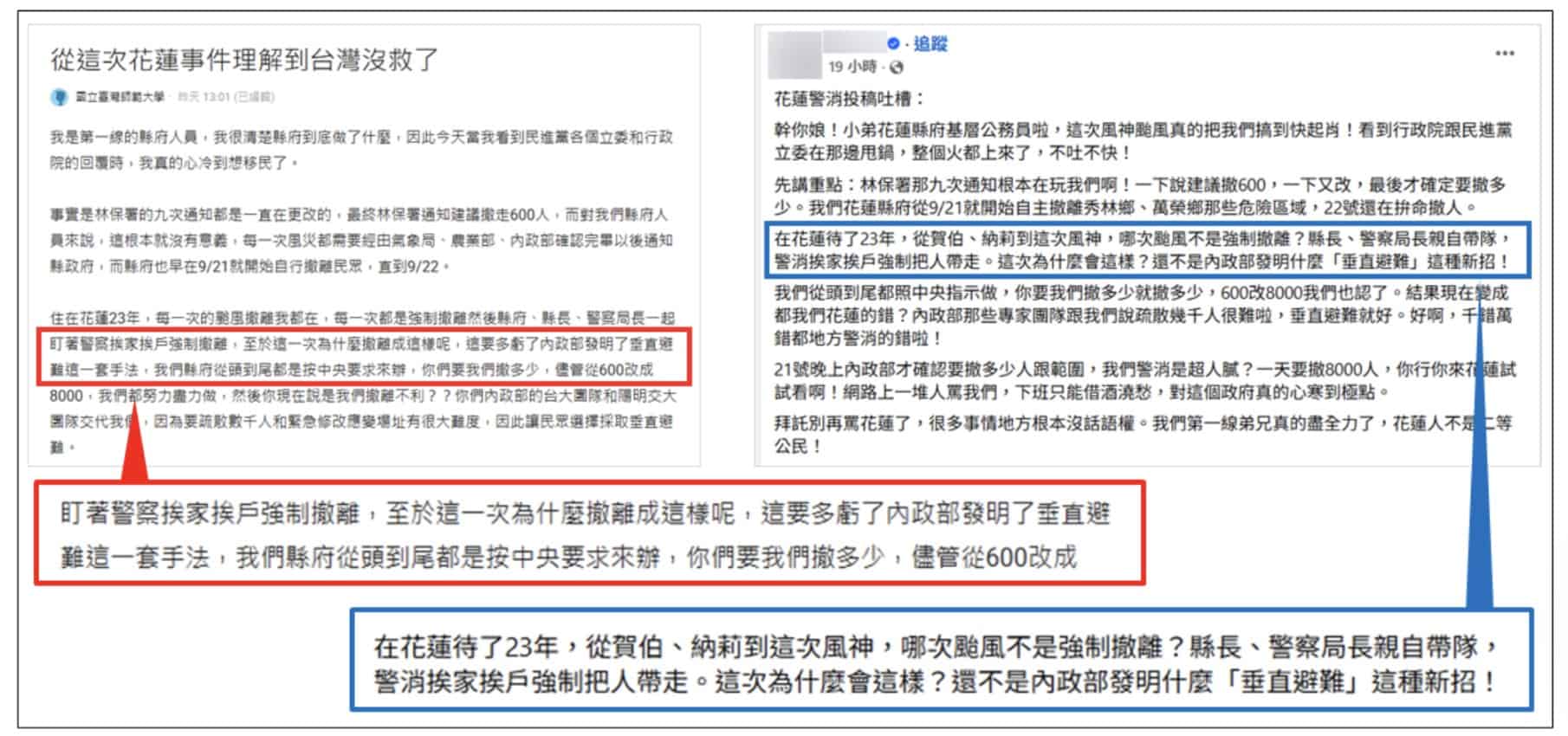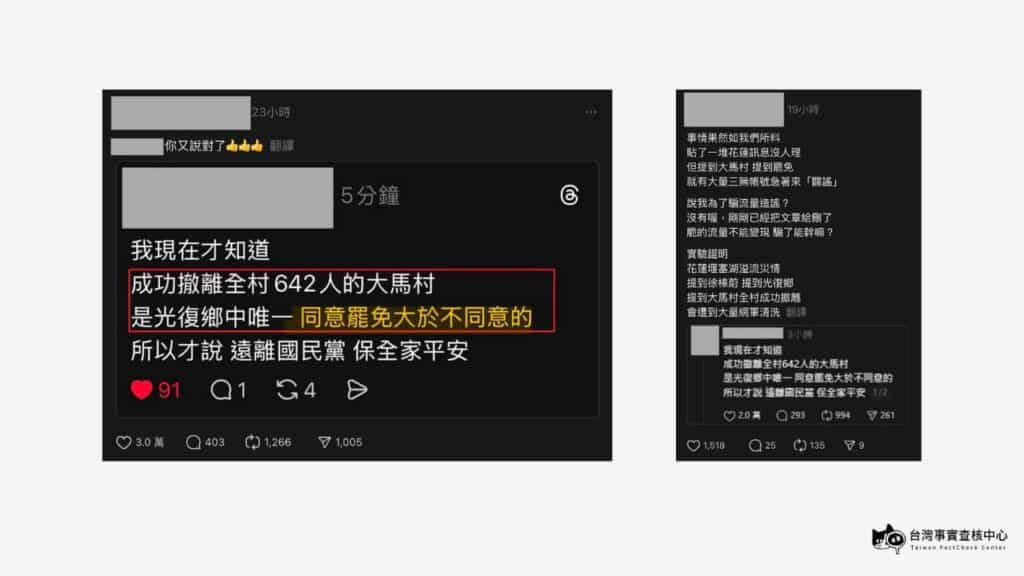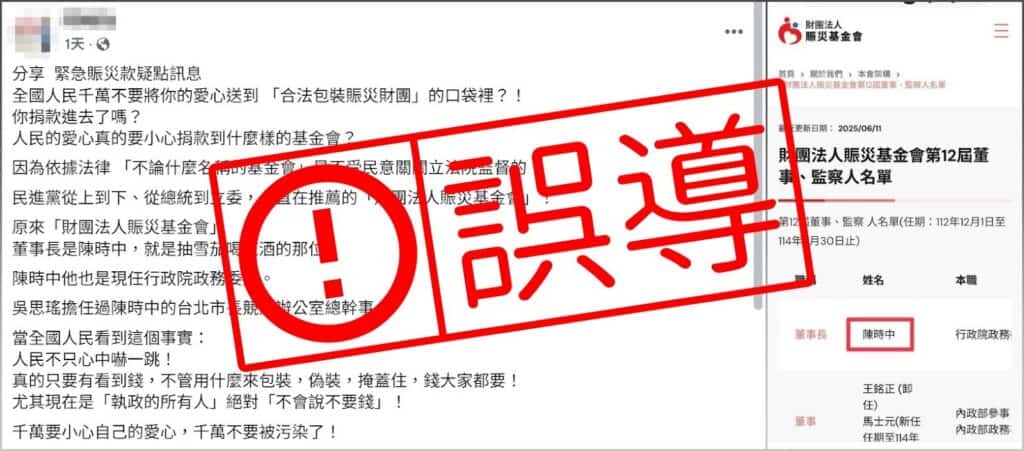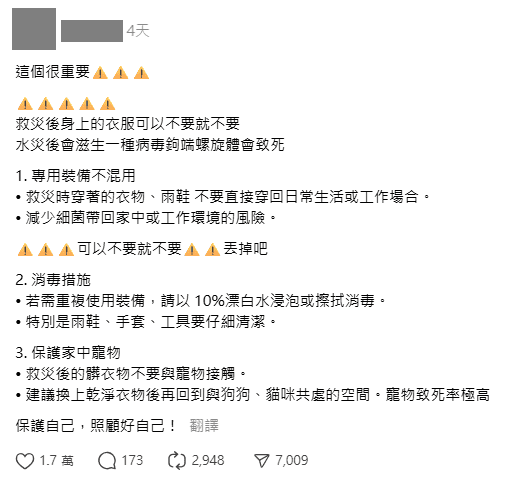
By Hui-An Ho & Wei-Ting Chen
In late September 2025, Super Typhoon Ragasa devastated eastern Taiwan, causing the overflow and collapse of a barrier lake along Mataian Creek in Hualien. The resulting flood inundated Guangfu Township, leaving 19 dead, five missing, and over a hundred injured as of October 9. Unsurprisingly, the disaster sparked a wave of public discussion and information circulation across Taiwan.
Yet in Taiwan’s deeply polarized political climate—where the central and Hualien county governments are controlled by rival parties—those conversations quickly escalated into partisan finger-pointing. Misleading and false claims emerged from all sides, blurring the facts and further eroding social trust.
Still, the crisis revealed Taiwan’s resilience and compassion.
Moved by the disaster, hundreds of volunteers—including many from outside the region and even from abroad—rushed to Hualien with tools in hand, cooking meals and helping residents clear debris. These tireless helpers earned the nickname “Shovel Supermen.” But even this outpouring of goodwill was accompanied by misinformation.
Some viral posts raised unwarranted fears, leading TFC to publish a Volunteer Safety Guide to clarify common concerns and provide accurate, actionable advice.
As of this issue, TFC has published seven fact-checks and two in-depth explainers on disaster-related claims, covering everything from rescue operations to viral rumors. We’ve also launched a dedicated info hub on our website featuring explainers, podcasts, and two short videos aimed at helping more people access verified information in multiple formats.
This catastrophe not only tested Taiwan’s emergency response and intergovernmental communication—it also challenged the public’s media literacy and resilience against political disinformation.

When Disaster Meets Politics: How Partisan Tensions Fueled False Information
Natural disasters are not new to Taiwan, a mountainous island on the typhoon path and earthquake belt. But the political context surrounding the Mataian Creek barrier lake overflow made it particularly volatile. Just two months earlier, Taiwan had held an unprecedented recall vote targeting 31 opposition lawmakers from the Kuomintang (KMT). Among them was Fu Kun-Chi, a prominent KMT legislator—and former Hualien County magistrate—whose wife is now the current Hualien County chief.
Though all KMT lawmakers ultimately survived the recall, the political tension lingered. So when the barrier lake burst in Fu’s home constituency, a wave of political blame followed. Debates erupted over whether the lake was properly monitored, whether evacuation orders came in time, and whether the central or local government had failed in their response.
One major flashpoint was the debate over “vertical evacuation.” All fatalities occurred within designated evacuation zones, prompting Hualien officials—including Fu Kun-Chi—to criticize Taiwan’s Ministry of the Interior. They claimed that the central government’s endorsement of vertical evacuation (staying on the second floor rather than leaving entirely) hindered local officials from enforcing mandatory evacuations. Anonymous online posts claiming to be from local police or government staff echoed this view, alleging that “vertical evacuation” was a new policy imposed from above.

TFC investigated the claims by reviewing official livestreams, public statements, and interviewing civil engineers—including those who attended the Ministry’s emergency planning meeting on September 21. We published an in-depth explainer breaking down the timeline and rationale behind the decisions.
Experts disagree on whether vertical evacuation was appropriate in this case. While some said it was a “last resort” given the lack of time and resources, others argued that, based on actual water levels, it could have been a reasonable option. Still others emphasized that vertical evacuation should only be used when escape is no longer possible—not offered as a first-line choice.
Beyond policy debate, real-world implementation raised questions: Were people properly informed? Did they understand the risks? Could elderly residents reach a second floor in time? These practical concerns are now under legal investigation by prosecutors.Adding fuel to the fire, one viral rumor falsely linked the success of evacuation efforts to anti-Fu Kun-Chi sentiment. It claimed that Dama Village, which suffered no casualties thanks to swift evacuation, had voted in favor of recalling Fu. In reality, voting records showed the opposite.

Donation Rumors Undermine Disaster Relief Trust
Misinformation didn’t stop at evacuation debates—it also targeted the donation system itself. After the Ministry of Health and Welfare launched an official disaster relief fund on September 25, rumors began circulating online.One viral post on Threads, which gained over 2,000 likes and nearly 500 shares, falsely claimed that donations to the central government would be funneled back to Hualien authorities. Others painted the disaster fund as a partisan tool of the ruling party.


These posts eroded trust in public donation channels. Some netizens began organizing their own direct donation drives, pledging to hand-deliver supplies to affected areas. While well-intentioned, such efforts risk bypassing accountability systems and even exposing donors to scams.
The official relief foundation clarified that all funds are earmarked for specific uses, subject to auditing and documentation requirements. Disbursements to local governments or NGOs must meet strict criteria and are not handed out freely. Misleading posts, however, may push people toward unregulated donation methods with fewer protections.
Volunteer Misinformation: From “Shovel Supermen” to Health Scares
As focus shifted to recovery in Guangfu Township, thousands of volunteers flooded in to help clean up. Social media was soon filled with first-person stories—some factual, others exaggerated or misleading.One post, shared over 7,000 times, warned that volunteers should throw away all clothing worn in the disaster zone due to leptospirosis. Experts debunked the claim: while leptospirosis risk increases after floods, contaminated clothes pose no threat if properly washed.


Controversy also followed remarks from former interior minister and civil engineering professor Lee Hong-Yuan. While participating in disaster evaluations, he warned that untrained volunteers might cause more harm than good and could spread bacteria to other areas. This sparked debate over whether such concerns were valid or unnecessarily alarmist.
Experts clarified that flood-affected zones are not considered infectious disease zones. Most health risks stem from direct contact with contaminated water or soil—not from person-to-person transmission. Still, TFC published a Volunteer Safety Guide covering health, hygiene, and even mental well-being for those heading into disaster zones.
Wrong Country: Viral Video of India Misrepresented as Hualien Disaster
One of the most viral videos showed a torrent of mud sweeping away homes, labeled as footage from Hualien after Typhoon Ragasa. The video appeared across platforms with hashtags referencing Taiwan, Hualien residents, and the storm’s name. But the footage wasn’t from Taiwan at all—it was from India.

Fact-checkers at TFC and MyGoPen traced the original clip to a deadly landslide in Dharali village, Uttarakhand, India, caused by monsoon rains weeks earlier.
Want to Know More?
To stay informed about verified facts and updates, visit our dedicated coverage hub on the Mataian Creek disaster for accurate updates and media literacy resources. It includes fact-checks, explainers, videos, podcasts, and expert interviews.
